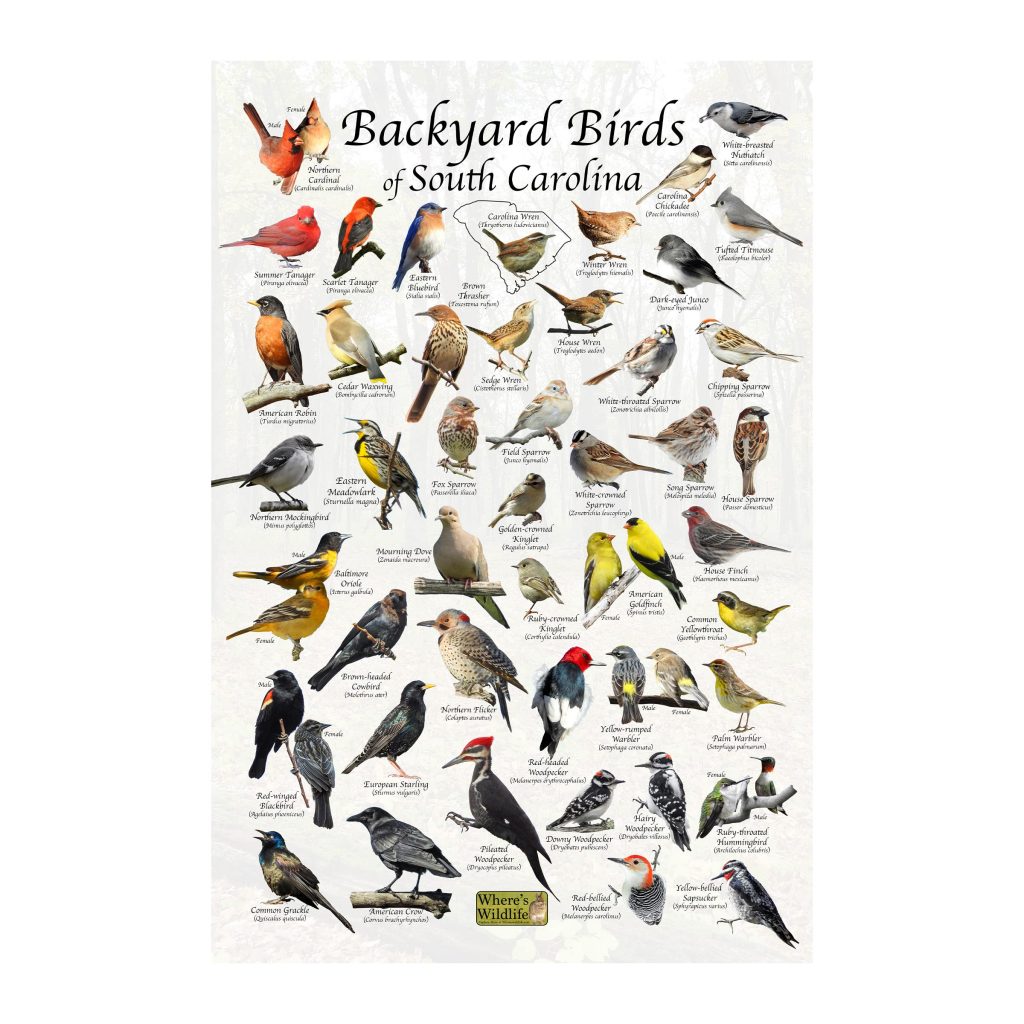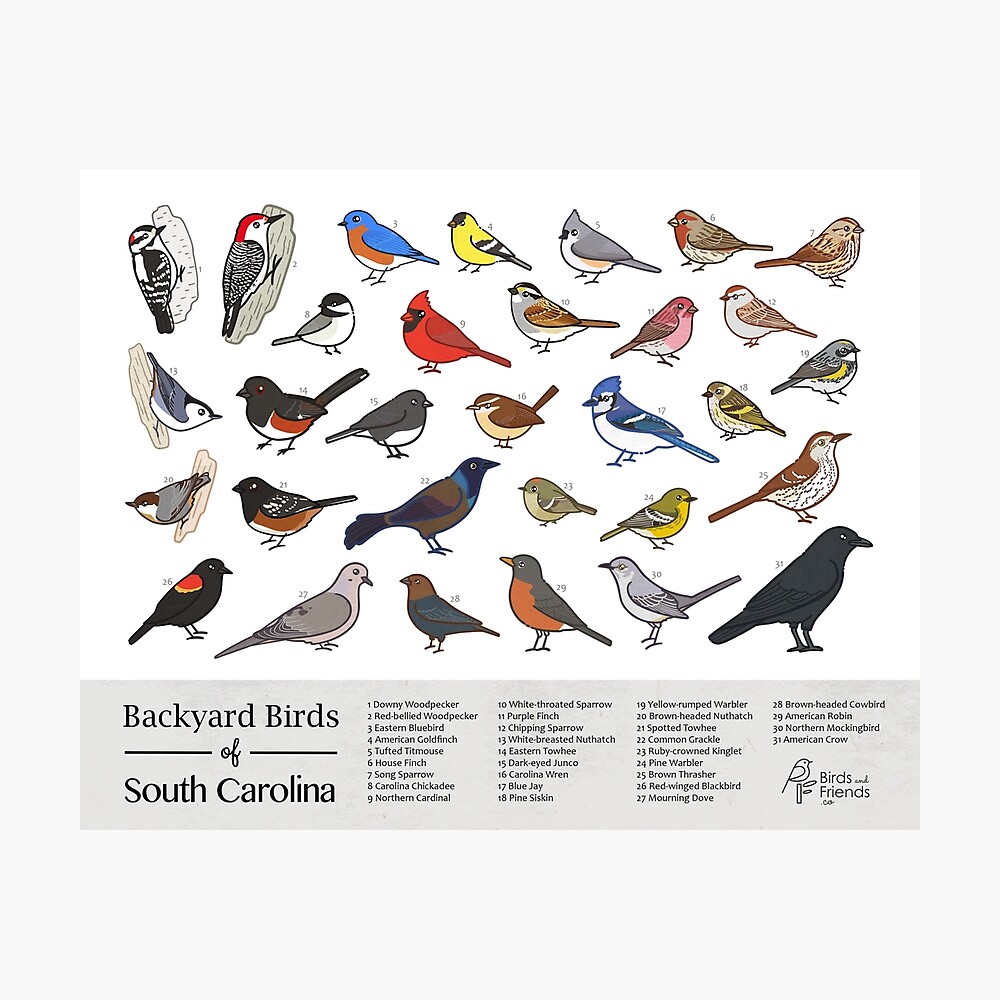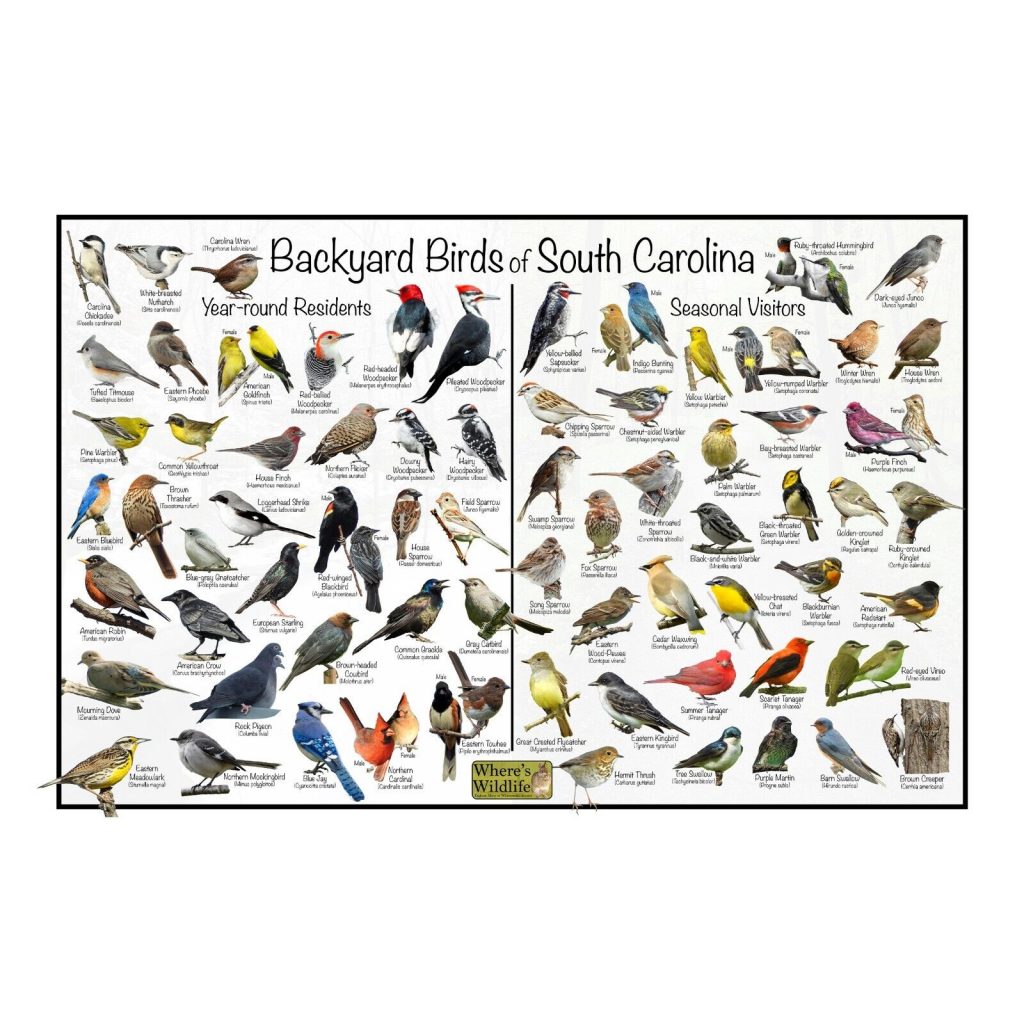Step into the backyard birdwatching world of South Carolina with this informative guide. Filled with beautiful pictures and handy identification tips, this article dives into the most common backyard birds in the state. Drawing data from the reputable citizen science program eBird, readers can expect accurate and reliable information. From the striking Northern Cardinal to the charismatic Carolina Wren, this guide introduces you to the feathered friends that are likely to grace your backyard. Not only does it help you identify these birds, but it also includes tips on how to attract them to your own little avian oasis. Whether you’re a seasoned bird enthusiast or just starting out, this guide provides a wealth of knowledge and resources to enhance your birdwatching experience in South Carolina.
Common Backyard Birds in South Carolina
South Carolina, with its diverse habitats ranging from forests to swamps, is home to a wide variety of bird species. This article aims to provide comprehensive information on the most common backyard birds in South Carolina. The information presented here is compiled from data collected by the citizen science program eBird, making it more accurate than other similar articles. Additionally, pictures and identification tips for each bird species mentioned will be provided, along with tips on how to attract these beautiful creatures to your backyard. Lastly, this article will offer resources for further bird identification and bird watching in South Carolina.

Northern Cardinal (Cardinalis cardinalis)
Description and Identification
The Northern Cardinal is the most common bird species in South Carolina. With its vibrant red color and distinctive crest, it is easily recognizable. The male cardinal boasts bright red plumage, while the female has a more muted brown coloration. Both genders have a black mask around their eyes. The Northern Cardinal is a relatively large bird, measuring around 8 to 9 inches in length.
Habitat and Range
The Northern Cardinal can be found throughout South Carolina all year round. It prefers to inhabit woodlands, gardens, and shrublands. Cardinals are highly adaptable birds and can thrive in both urban and rural areas.
Feeding and Behavior
Cardinals primarily feed on seeds, fruits, and insects. They are often seen frequenting backyard bird feeders, especially during the winter months. Cardinals are known for their melodious song, which is often described as a series of clear whistles.
Attracting to Your Backyard
To attract Northern Cardinals to your backyard, provide them with a variety of birdseed, including sunflower seeds, safflower seeds, and millet. They are ground feeders, so a ground feeding tray or platform feeder is ideal. Additionally, providing dense shrubs and trees for nesting and cover will attract cardinals to your yard.
Pictures and Identification Tips
Carolina Wren (Thryothorus ludovicianus)
Description and Identification
The Carolina Wren is another common bird species in South Carolina. It is a small bird with a distinctive rust-brown coloration on its upperparts and a creamy white underside. The Carolina Wren has a prominent white eyebrow stripe, giving it a unique and charming appearance.
Habitat and Range
Carolina Wrens can be found throughout South Carolina year-round. They prefer to inhabit dense vegetation, such as forests, swamps, and shrublands. They are also commonly found in suburban and urban areas, making use of gardens and yards as their habitat.
Feeding and Behavior
Carolina Wrens primarily feed on insects, spiders, and small invertebrates. They are known for their loud and melodious song, which can be heard all year round. These wrens are incredibly active birds, constantly hopping and flitting around in search of food.
Attracting to Your Backyard
To attract Carolina Wrens to your backyard, provide them with a variety of insects and invertebrates. They are also known to enjoy suet, especially during the colder months. Dense shrubs and trees are essential for their nesting and roosting needs.
Pictures and Identification Tips
American Goldfinch (Spinus tristis)
Description and Identification
The American Goldfinch, also known as the Eastern Goldfinch, is a small songbird with a vibrant yellow plumage during the breeding season. The male goldfinches boast bright yellow feathers with black wings, while the females have a more muted olive coloration.
Habitat and Range
American Goldfinches are found throughout South Carolina, particularly during the summer months. They prefer open fields, meadows, and grasslands, where they can find their preferred food sources.
Feeding and Behavior
These charming birds primarily feed on the seeds of flowers, such as thistles and sunflowers. They have a unique feeding behavior, clinging to flower heads and extracting seeds with their specialized bills.
Attracting to Your Backyard
To attract American Goldfinches, provide them with a variety of nyjer and sunflower seeds. Planting native wildflowers, such as coneflowers and black-eyed Susans, will also help attract these birds to your yard.
Pictures and Identification Tips
Eastern Bluebird (Sialia sialis)
Description and Identification
The Eastern Bluebird is a small thrush with striking blue plumage on its upperparts and a rusty orange coloration on its throat and breast. The male bluebird has a brighter blue color compared to the female, and both genders have a white belly.
Habitat and Range
Eastern Bluebirds are found throughout South Carolina, particularly in open habitats such as meadows, pastures, and orchards. They rely on open spaces with scattered trees for nesting and perching.
Feeding and Behavior
Eastern Bluebirds primarily feed on insects, such as beetles, caterpillars, and grasshoppers. They also eat berries and fruits when insects are less abundant. Bluebirds can often be seen perching on branches or hovering near the ground while foraging.
Attracting to Your Backyard
To attract Eastern Bluebirds, provide them with mealworms, suet, and a water source. Installing bluebird houses in open spaces away from dense vegetation will enhance their nesting opportunities.
Pictures and Identification Tips

Tufted Titmouse (Baeolophus bicolor)
Description and Identification
The Tufted Titmouse is a small songbird with a gray back and a lighter gray underside. It has a distinct crest on its head, which gives it a tufted appearance. The Tufted Titmouse is often seen hanging upside down while foraging for food.
Habitat and Range
Tufted Titmice are found throughout South Carolina year-round. They prefer to inhabit deciduous and mixed forests, woodlands, and suburban areas with mature trees.
Feeding and Behavior
These active birds primarily feed on insects, seeds, and nuts. They have a unique habit of storing surplus food for later consumption, often hiding it in bark crevices or other hidden locations.
Attracting to Your Backyard
To attract Tufted Titmice to your backyard, provide them with a variety of suet, sunflower seeds, and peanuts. Offering nest boxes or natural cavities in mature trees will also increase their likelihood of nesting in your yard.
Pictures and Identification Tips
Mourning Dove (Zenaida macroura)
Description and Identification
The Mourning Dove is a medium-sized bird with a grayish-brown plumage and a slender body. It has a small head and a long, tapering tail. Mourning Doves are known for their mournful cooing call, which can often be heard in the early morning and evening.
Habitat and Range
Mourning Doves are found throughout South Carolina year-round. They inhabit a variety of habitats, including open woodlands, urban areas, and agricultural fields.
Feeding and Behavior
These doves primarily feed on seeds, grains, and fruits. They are often seen foraging on the ground in groups, scratching and pecking for food.
Attracting to Your Backyard
To attract Mourning Doves to your backyard, provide them with a variety of seeds, such as millet and cracked corn, scattered on the ground. Offering a clean source of water will also be appreciated by these birds.
Pictures and Identification Tips

Carolina Chickadee (Poecile carolinensis)
Description and Identification
The Carolina Chickadee is a small songbird with a distinctive black cap and bib on a white face. It has a gray back and wings, and its underside is a pale buff color. Carolina Chickadees are known for their cheerful and melodic chick-a-dee-dee-dee call.
Habitat and Range
Carolina Chickadees are found throughout South Carolina year-round. They inhabit woodland areas, forests, and suburban landscapes with mature trees.
Feeding and Behavior
These active birds primarily feed on insects, seeds, and berries. They have a unique ability to hang upside down while foraging for food.
Attracting to Your Backyard
To attract Carolina Chickadees to your backyard, provide them with a variety of sunflower seeds, peanuts, and suet. Offering nest boxes or natural cavities will increase their chance of nesting in your yard.
Pictures and Identification Tips
Northern Mockingbird (Mimus polyglottos)
Description and Identification
The Northern Mockingbird is a medium-sized songbird with grayish-brown plumage and a white underside. It has long wings and a long tail with white wing bars. The Northern Mockingbird is known for its incredible ability to mimic the songs of other birds.
Habitat and Range
Northern Mockingbirds are found throughout South Carolina year-round. They inhabit a variety of habitats, including woodlands, gardens, and suburban areas.
Feeding and Behavior
These omnivorous birds feed on a variety of food sources, including insects, berries, and fruits. They are highly territorial birds and will defend their feeding areas fiercely.
Attracting to Your Backyard
To attract Northern Mockingbirds to your backyard, provide them with a variety of berries and fruits, such as holly berries and grapes. Offering a clean water source and dense shrubs for cover will also attract these birds.
Pictures and Identification Tips

House Finch (Haemorhous mexicanus)
Description and Identification
The House Finch is a small songbird with a colorful plumage. The males have a reddish color on their head, breast, and rump, while the females have a more muted brown coloration. Both genders have streaked underparts and a distinctive conical bill.
Habitat and Range
House Finches are found throughout South Carolina, particularly in suburban and urban areas. They inhabit a variety of habitats, including residential areas, gardens, and open woodlands.
Feeding and Behavior
These finches primarily feed on seeds, fruits, and insects. They are often seen perching on tree branches or hopper-style bird feeders.
Attracting to Your Backyard
To attract House Finches to your backyard, provide them with a variety of seeds, such as sunflower seeds and nyjer. They are also known to visit bird baths for water, so keeping one clean and filled will increase their presence in your yard.
Pictures and Identification Tips
Resources for Bird Identification and Bird Watching
eBird – Citizen Science Program
eBird is a popular citizen science program that allows birdwatchers to submit their observations and contribute to global bird databases. It provides a wealth of information and resources for bird identification and bird monitoring. Visit their website at [insert link here].
South Carolina Audubon Society
The South Carolina Audubon Society is a nonprofit organization dedicated to the conservation of birds and their habitats in South Carolina. They offer a variety of resources, including bird identification guides, field trips, and educational programs. Learn more about their work at [insert link here].
Birding Trails and Hotspots
South Carolina is home to numerous birding trails and hotspots where birdwatchers can observe a diverse range of bird species. Some popular locations include Huntington Beach State Park, Congaree National Park, and the Francis Beidler Forest Audubon Center and Sanctuary.
Field Guides and Apps
Field guides and smartphone apps are invaluable resources for bird identification in the field. Some recommended field guides for South Carolina include the “Sibley Field Guide to Birds of Eastern North America” and the “National Geographic Field Guide to Birds of North America.” Smartphone apps like “Merlin Bird ID” and “iBird” also provide comprehensive bird identification features.
In conclusion, South Carolina is a birdwatcher’s paradise with a rich diversity of bird species. By providing the right resources and creating a welcoming habitat in your backyard, you can attract and enjoy the company of these beautiful birds. Remember to use the provided identification tips and consult the recommended resources for further information and guidance on bird identification and bird watching in South Carolina. Happy birding!

Leave a Reply